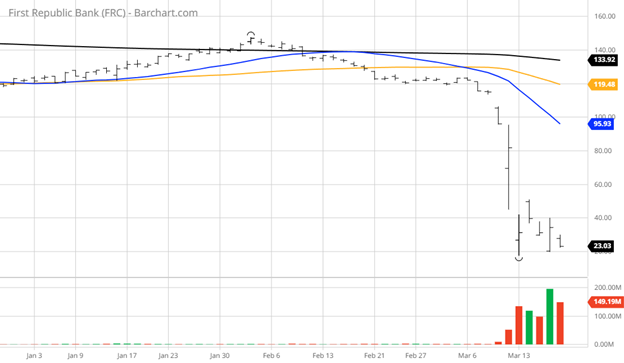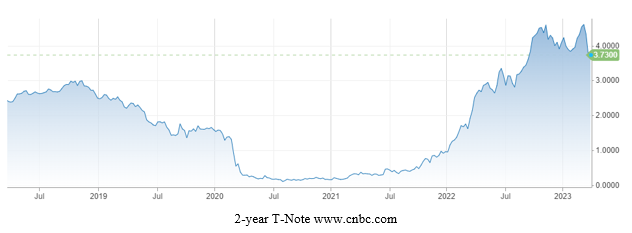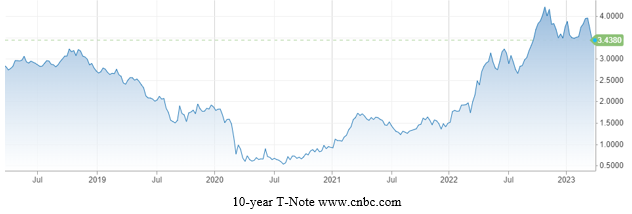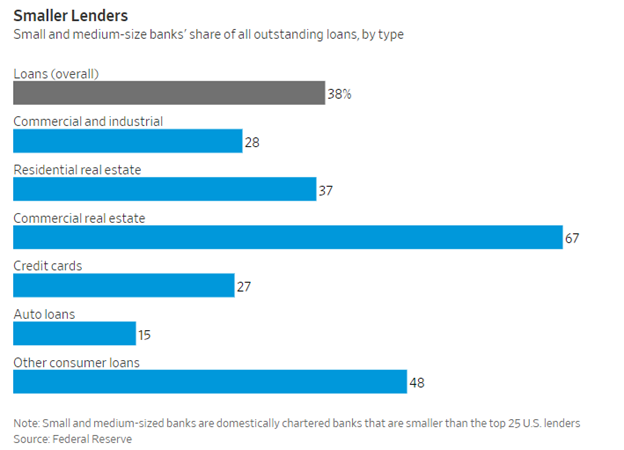by Bryan Perry
March 21, 2023
This past week of volatility in the banking sector was epic, along the lines of how the 2008 crisis began, when some high-profile mortgage lenders and investment banks dealing in risky practices went bankrupt, filed for Chapter 11, or were acquired for pennies on the dollar. To say that the recent events in the regional bank sector (and Credit Suisse) are surreal would be an understatement. Oh, how history does tend to repeat itself – in various forms – but with the same pattern of hubris, greed, and sheer stupidity.
Take Barney Frank for instance. As the co-author of the 2010 Dodd-Frank Act, enacted to prevent the excessive risk-taking that led to the 2008 financial crisis, it appears there is some twisted irony as to how Mr. Frank was a sitting board member of the now-failed Signature Bank that was one of only a handful of banks allowing customers to deposit and transact in cryptocurrency assets 24/7 beginning in 2018.
One can also look at the demise of FTX and Sam Bankman-Fried as the spark that led to the collapse of crypto-centric Silvergate Bank and the further chain reaction that ignited fears of depositors at Silicon Valley Bank and Signature Bank for their exposure to start-ups, crypto, and commercial office space.
From there, the market was taking down shares of banks with large uninsured deposit bases, with First Republic Bank (FRC) being the newest poster child of this brand of contagion. No sooner than one day after 11 banks transferred $30 billion to First Republic to shore up their deposit base, it was reported that top executives at First Republic sold millions of dollars of company stock in the previous two months, so the rally in FRC last Thursday on the rescue plan fizzled Friday on news of the stock sales by insiders.

Graphs are for illustrative and discussion purposes only. Please read important disclosures at the end of this commentary.
The other deadly transgression by bank executives was reaching for yields on their bond portfolio by investing in long-term bonds – even though the difference in yields to that of short-term bonds was minuscule – thereby taking a huge risk of principle. When money rained on the bank system from the roughly $4.7 trillion created in pandemic stimulus, banks invested heavily in long-dated government bonds. When the rate on the 10-yr Treasury briefly rose to 1.75% in March 2021, banks rushed to buy.
Going for 1.75% instead of accepting 0.40% on 3-year T-Notes looks quite short-sighted now. At 1.75% for 10-year paper, there is really only one direction yields of that duration can go – higher – and only one direction for long-term bond prices to go – lower. To the extent that these risk managers didn’t ladder their bond holdings borders on reckless, as if inflation from printing trillions of dollars wouldn’t somehow soon arrive. All that risk gets you is a spread of 1.3% between the 3-yr and 10-yr Treasuries.

Graphs are for illustrative and discussion purposes only. Please read important disclosures at the end of this commentary.

Graphs are for illustrative and discussion purposes only. Please read important disclosures at the end of this commentary.
The obvious question now is how many, and to what extent, are other banks also under water with their bond portfolios, and what is the amount of their uninsured deposits, and their exposure to commercial office space? In recent days, numerous CEOs of small- to mid-size banks put forth statements that what happened at these big banks is unique, in that they engaged in non-traditional activities. They say that “all is well,” and their institutions are safe and sound; yet there is no mention of their Treasury holdings and a maturity schedule, a breakdown of commercial real estate loans, and their level of uninsured deposits.
Transparency is what investors and depositors want most. Banks should immediately make public their current holdings and details of their financials and balance sheets. Warm and fuzzy statements do nothing to shore up confidence. Suspicions arise when banks say, “There is nothing to worry about,” and then don’t supply specific numbers. With first-quarter earnings season approaching, investors will have ample opportunity to investigate the details of each bank during the earnings calls following quarterly results.
The Wall Street Journal reported on the importance of smaller banks on March 19, when they wrote:
“Smaller banks are crucial drivers of credit growth, the fuel that powers the economy. Banks smaller than the top 25 largest account for around 38% of all outstanding loans, according to Federal Reserve data. They account for 67% of commercial real estate lending. The possibility that other banks have similar problems has triggered a selloff of financial stocks as investors scrutinize bank solvency. This, in turn, stoked public alarm about the safety of deposits and the size of unrealized losses.”

Graphs are for illustrative and discussion purposes only. Please read important disclosures at the end of this commentary.
This week will hopefully begin to provide some much-needed clarity of risks within the wider banking sector. It is widely accepted that lending standards just tightened up for both businesses and consumers in order to raise capital ratios. Additionally, some pundits are suggesting that recent events could trigger a wave of weaker banks being swallowed up by bigger banks to avoid the potential of further bank runs. These mergers could be voluntary, or at the direction of state bank regulatory agencies.
What the market seeks most is a rapid response by the bank industry, the Fed, and Treasury to prevent a further ripple effect. The fact that the Fed and Treasury jointly agreed to guarantee all deposits above the $250K FDIC level of insurance at SVB is fueling a fresh debate about the moral hazard of universal deposit insurance. The potential for unintended consequences is high. If all funds are guaranteed at all levels, there’s at least some incentive to take on higher risks with depositors’ funds to chase profits.
What should come of recent events is that there should be more stress testing with stricter mandates about where capital is concentrated. I think if these directives were made known to markets sooner rather than later, the ground under the banking sector might stop shaking.
Let’s hope sound minds and proper decision making prevail in the days ahead.
Navellier & Associates Inc. does not own Silicon Valley Bank (SVB), Signature Bank, Silvergate Bank, Credit Suisse Group (CS), or First Republic Bank (FRC) in managed accounts. Brian Perry does not personally own Silicon Valley Bank (SVB), Signature Bank, Silvergate Bank, Credit Suisse Group (CS), or First Republic Bank (FRC).
All content above represents the opinion of Bryan Perry of Navellier & Associates, Inc.
Also In This Issue
A Look Ahead by Louis Navellier
The Best and Quickest Ways Out of This Banking Crisis
Income Mail by Bryan Perry
Rapid Transparency Can Quell Any Crisis of Confidence in the Banking Sector
Growth Mail by Gary Alexander
Beware The Ides of March (Part 2)
Global Mail by Ivan Martchev
QE Has Restarted
Sector Spotlight by Jason Bodner
What To Do When You See Red
View Full Archive
Read Past Issues Here

Bryan Perry
SENIOR DIRECTOR
Bryan Perry is a Senior Director with Navellier Private Client Group, advising and facilitating high net worth investors in the pursuit of their financial goals.
Bryan’s financial services career spanning the past three decades includes over 20 years of wealth management experience with Wall Street firms that include Bear Stearns, Lehman Brothers and Paine Webber, working with both retail and institutional clients. Bryan earned a B.A. in Political Science from Virginia Polytechnic Institute & State University and currently holds a Series 65 license. All content of “Income Mail” represents the opinion of Bryan Perry
Important Disclosures:
Although information in these reports has been obtained from and is based upon sources that Navellier believes to be reliable, Navellier does not guarantee its accuracy and it may be incomplete or condensed. All opinions and estimates constitute Navellier’s judgment as of the date the report was created and are subject to change without notice. These reports are for informational purposes only and are not a solicitation for the purchase or sale of a security. Any decision to purchase securities mentioned in these reports must take into account existing public information on such securities or any registered prospectus.To the extent permitted by law, neither Navellier & Associates, Inc., nor any of its affiliates, agents, or service providers assumes any liability or responsibility nor owes any duty of care for any consequences of any person acting or refraining to act in reliance on the information contained in this communication or for any decision based on it.
Past performance is no indication of future results. Investment in securities involves significant risk and has the potential for partial or complete loss of funds invested. It should not be assumed that any securities recommendations made by Navellier. in the future will be profitable or equal the performance of securities made in this report. Dividend payments are not guaranteed. The amount of a dividend payment, if any, can vary over time and issuers may reduce dividends paid on securities in the event of a recession or adverse event affecting a specific industry or issuer.
None of the stock information, data, and company information presented herein constitutes a recommendation by Navellier or a solicitation to buy or sell any securities. Any specific securities identified and described do not represent all of the securities purchased, sold, or recommended for advisory clients. The holdings identified do not represent all of the securities purchased, sold, or recommended for advisory clients and the reader should not assume that investments in the securities identified and discussed were or will be profitable.
Information presented is general information that does not take into account your individual circumstances, financial situation, or needs, nor does it present a personalized recommendation to you. Individual stocks presented may not be suitable for every investor. Investment in securities involves significant risk and has the potential for partial or complete loss of funds invested. Investment in fixed income securities has the potential for the investment return and principal value of an investment to fluctuate so that an investor’s holdings, when redeemed, may be worth less than their original cost.
One cannot invest directly in an index. Index is unmanaged and index performance does not reflect deduction of fees, expenses, or taxes. Presentation of Index data does not reflect a belief by Navellier that any stock index constitutes an investment alternative to any Navellier equity strategy or is necessarily comparable to such strategies. Among the most important differences between the Indices and Navellier strategies are that the Navellier equity strategies may (1) incur material management fees, (2) concentrate its investments in relatively few stocks, industries, or sectors, (3) have significantly greater trading activity and related costs, and (4) be significantly more or less volatile than the Indices.
ETF Risk: We may invest in exchange traded funds (“ETFs”) and some of our investment strategies are generally fully invested in ETFs. Like traditional mutual funds, ETFs charge asset-based fees, but they generally do not charge initial sales charges or redemption fees and investors typically pay only customary brokerage fees to buy and sell ETF shares. The fees and costs charged by ETFs held in client accounts will not be deducted from the compensation the client pays Navellier. ETF prices can fluctuate up or down, and a client account could lose money investing in an ETF if the prices of the securities owned by the ETF go down. ETFs are subject to additional risks:
- ETF shares may trade above or below their net asset value;
- An active trading market for an ETF’s shares may not develop or be maintained;
- The value of an ETF may be more volatile than the underlying portfolio of securities the ETF is designed to track;
- The cost of owning shares of the ETF may exceed those a client would incur by directly investing in the underlying securities; and
- Trading of an ETF’s shares may be halted if the listing exchange’s officials deem it appropriate, the shares are delisted from the exchange, or the activation of market-wide “circuit breakers” (which are tied to large decreases in stock prices) halts stock trading generally.
Grader Disclosures: Investment in equity strategies involves substantial risk and has the potential for partial or complete loss of funds invested. The sample portfolio and any accompanying charts are for informational purposes only and are not to be construed as a solicitation to buy or sell any financial instrument and should not be relied upon as the sole factor in an investment making decision. As a matter of normal and important disclosures to you, as a potential investor, please consider the following: The performance presented is not based on any actual securities trading, portfolio, or accounts, and the reported performance of the A, B, C, D, and F portfolios (collectively the “model portfolios”) should be considered mere “paper” or pro forma performance results based on Navellier’s research.
Investors evaluating any of Navellier & Associates, Inc.’s, (or its affiliates’) Investment Products must not use any information presented here, including the performance figures of the model portfolios, in their evaluation of any Navellier Investment Products. Navellier Investment Products include the firm’s mutual funds and managed accounts. The model portfolios, charts, and other information presented do not represent actual funded trades and are not actual funded portfolios. There are material differences between Navellier Investment Products’ portfolios and the model portfolios, research, and performance figures presented here. The model portfolios and the research results (1) may contain stocks or ETFs that are illiquid and difficult to trade; (2) may contain stock or ETF holdings materially different from actual funded Navellier Investment Product portfolios; (3) include the reinvestment of all dividends and other earnings, estimated trading costs, commissions, or management fees; and, (4) may not reflect prices obtained in an actual funded Navellier Investment Product portfolio. For these and other reasons, the reported performances of model portfolios do not reflect the performance results of Navellier’s actually funded and traded Investment Products. In most cases, Navellier’s Investment Products have materially lower performance results than the performances of the model portfolios presented.
This report contains statements that are, or may be considered to be, forward-looking statements. All statements that are not historical facts, including statements about our beliefs or expectations, are “forward-looking statements” within the meaning of The U.S. Private Securities Litigation Reform Act of 1995. These statements may be identified by such forward-looking terminology as “expect,” “estimate,” “plan,” “intend,” “believe,” “anticipate,” “may,” “will,” “should,” “could,” “continue,” “project,” or similar statements or variations of such terms. Our forward-looking statements are based on a series of expectations, assumptions, and projections, are not guarantees of future results or performance, and involve substantial risks and uncertainty as described in Form ADV Part 2A of our filing with the Securities and Exchange Commission (SEC), which is available at www.adviserinfo.sec.gov or by requesting a copy by emailing info@navellier.com. All of our forward-looking statements are as of the date of this report only. We can give no assurance that such expectations or forward-looking statements will prove to be correct. Actual results may differ materially. You are urged to carefully consider all such factors.
FEDERAL TAX ADVICE DISCLAIMER: As required by U.S. Treasury Regulations, you are informed that, to the extent this presentation includes any federal tax advice, the presentation is not written by Navellier to be used, and cannot be used, for the purpose of avoiding federal tax penalties. Navellier does not advise on any income tax requirements or issues. Use of any information presented by Navellier is for general information only and does not represent tax advice either express or implied. You are encouraged to seek professional tax advice for income tax questions and assistance.
IMPORTANT NEWSLETTER DISCLOSURE:The hypothetical performance results for investment newsletters that are authored or edited by Louis Navellier, including Louis Navellier’s Growth Investor, Louis Navellier’s Breakthrough Stocks, Louis Navellier’s Accelerated Profits, and Louis Navellier’s Platinum Club, are not based on any actual securities trading, portfolio, or accounts, and the newsletters’ reported hypothetical performances should be considered mere “paper” or proforma hypothetical performance results and are not actual performance of real world trades. Navellier & Associates, Inc. does not have any relation to or affiliation with the owner of these newsletters. There are material differences between Navellier Investment Products’ portfolios and the InvestorPlace Media, LLC newsletter portfolios authored by Louis Navellier. The InvestorPlace Media, LLC newsletters contain hypothetical performance that do not include transaction costs, advisory fees, or other fees a client might incur if actual investments and trades were being made by an investor. As a result, newsletter performance should not be used to evaluate Navellier Investment services which are separate and different from the newsletters. The owner of the newsletters is InvestorPlace Media, LLC and any questions concerning the newsletters, including any newsletter advertising or hypothetical Newsletter performance claims, (which are calculated solely by Investor Place Media and not Navellier) should be referred to InvestorPlace Media, LLC at (800) 718-8289.
Please note that Navellier & Associates and the Navellier Private Client Group are managed completely independent of the newsletters owned and published by InvestorPlace Media, LLC and written and edited by Louis Navellier, and investment performance of the newsletters should in no way be considered indicative of potential future investment performance for any Navellier & Associates separately managed account portfolio. Potential investors should consult with their financial advisor before investing in any Navellier Investment Product.
Navellier claims compliance with Global Investment Performance Standards (GIPS). To receive a complete list and descriptions of Navellier’s composites and/or a presentation that adheres to the GIPS standards, please contact Navellier or click here. It should not be assumed that any securities recommendations made by Navellier & Associates, Inc. in the future will be profitable or equal the performance of securities made in this report.
FactSet Disclosure: Navellier does not independently calculate the statistical information included in the attached report. The calculation and the information are provided by FactSet, a company not related to Navellier. Although information contained in the report has been obtained from FactSet and is based on sources Navellier believes to be reliable, Navellier does not guarantee its accuracy, and it may be incomplete or condensed. The report and the related FactSet sourced information are provided on an “as is” basis. The user assumes the entire risk of any use made of this information. Investors should consider the report as only a single factor in making their investment decision. The report is for informational purposes only and is not intended as an offer or solicitation for the purchase or sale of a security. FactSet sourced information is the exclusive property of FactSet. Without prior written permission of FactSet, this information may not be reproduced, disseminated or used to create any financial products. All indices are unmanaged and performance of the indices include reinvestment of dividends and interest income, unless otherwise noted, are not illustrative of any particular investment and an investment cannot be made in any index. Past performance is no guarantee of future results.
